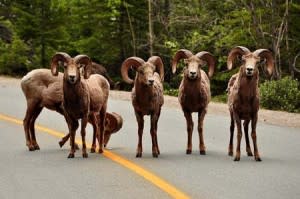Big Sky Wildlife Spotlight: Bighorn Sheep

Named after their curved horns, the Bighorn sheep is a species of sheep native to North America. There's a very good chance you'll see these animals when you visit Big Sky, Montana.
Bighorn sheep live in the town of Big Sky and the surrounding mountains of Southwest Montana. If you're lucky, you'll spot a herd near the entrance to Big Sky on Highway 64 licking salt near the side of the road, along Highway 191 near the banks of the Gallatin River, or deep in the mountains while on an epic Big Sky wilderness hike. These beautiful creatures are fun to spot, but always give them the respect that they deserve.
Read these interesting facts about bighorn sheep and share them with your friends:
- The bighorn sheep's scientific name is Ovis canadensis.
- Their horns can weigh up to 30 lbs.
- The horns represent the age of the ram. They are a status symbol, but they are also a weapon.
- The number of horn segments counted in the fall is one more than the ram's age.
- Males are called rams. Females are called ewes.
- Males have curved horns. Females have shorter horns with less curve.
- Males weigh 127-316 lbs, measure 36-41 inches at shoulder, and are 69-79 inches from nose to tail.
- Females weigh 75-188 lbs, measure 33-36 inches at shoulder, and are 54-67 inches from nose to tail.
- Bighorn sheep in the Rocky Mountains (near Big Sky) can exceed 500 lbs!
- Their two-toed split hooves help with grip and balance.
- They range from southern Canada through the western US and down into Mexico.
- They tend to live in alpine meadows, grassy mountain areas, rocky cliffs, and bluffs. They use cliffs and rocky terrain to escape from predators.
- Bighorn sheep are susceptible to diseases like scabies and pneumonia.
- Predators include bears, wolves, cougars, coyotes, bobcats, and lynxes. Golden eagles sometimes prey on lambs.
- Bighorn sheep are herbivores that eat grasses, twigs, leaves, herbs, shrubs. They also enjoy minerals and salt licks.
- In Big Sky, the Spanish Peak herd congregates next to the road because of the salt in treatment used to melt ice on the road.
- The Spanish peak herd is a native herd to Montana. It ranges from Durnham Meadows to the Beartrap Canyon. It is estimated to include 140-150 bighorn sheep.
- Bighorns typically swallow their food, regurgitate it later, then chew it up more before swallowing it again!
- In November, during the rut season, or mating season, bighorn rams will compete by butting heads. They race at 20 MPH and crack their foreheads against each other. The sound travels up to a mile away.
- Butting heads is done for mating rights or for dominance.
- Bighorn lambs are typically born in spring from April to June.
- Gray-brown coats help them blend in to the mountainside.
- Bighorn sheep are social animals that live in herds, or bands, of 5 to 15. Ewes and lambs typically live together and rams typically live separately in groups of 2 to 5.

- There are approximately 70,000 bighorn sheep in North America.
- Bighorn sheep can live over 10 years.
- They inhabit 3.7 million acres in Montana.
- In Montana, you can hunt Bighorn sheep. Learn more at FWP.MT.gov.
Bighorn sheep are wild animals. There are a few cases of bighorn sheep attacking humans, but it's rare. They are typically not aggressive animals, but can get defensive - especially during rutting season. You wouldn't want them to use their horns to butt you! Always give them plenty of space.
If you take any photos of bighorn sheep in Big Sky share them on social media and use the hashtag #visitbigsky.
See Also:

